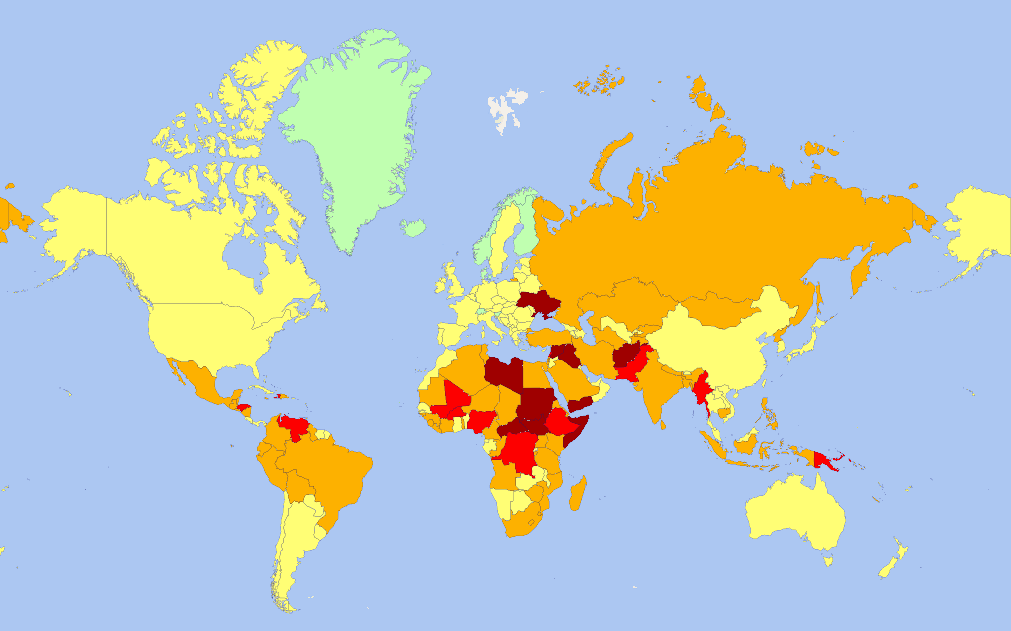World’s most dangerous countries to visit in 2025
No country saw their security risk decrease in the past 12 months, says International SOS

Your support helps us to tell the story
From reproductive rights to climate change to Big Tech, The Independent is on the ground when the story is developing. Whether it's investigating the financials of Elon Musk's pro-Trump PAC or producing our latest documentary, 'The A Word', which shines a light on the American women fighting for reproductive rights, we know how important it is to parse out the facts from the messaging.
At such a critical moment in US history, we need reporters on the ground. Your donation allows us to keep sending journalists to speak to both sides of the story.
The Independent is trusted by Americans across the entire political spectrum. And unlike many other quality news outlets, we choose not to lock Americans out of our reporting and analysis with paywalls. We believe quality journalism should be available to everyone, paid for by those who can afford it.
Your support makes all the difference.The world’s most dangerous countries to visit in 2025 have been revealed in a new study on security, health and climate change risks around the world.
Somalia, Sudan, South Sudan and the Central African Republic have been named as among the most dangerous countries to visit from an extreme security risk perspective, according to a risk map compiled by security and health risk services company, International SOS.
Also on the list were Yemen, Libya, Iraq, Afghanistan, Syria and Ukraine.
Countries that have a “high” security risk (one below an “extreme” security risk) include: Mali, Ethiopia, Nigeria, the Democratic Republic of the Congo, Pakistan, Myanmar, Papua New Guinea, Venezuela, Haiti and Honduras.
The annual map assesses the countries against various factors along with security risks, such as medical risks, climate change and mental health, to inform travellers and businesses about potential threats in countries across the globe.
The map provides organisations and businesses with risk ratings reflecting the impact of disruptive events such as conflict, infectious diseases and impacts of extreme weather events.
Countries were graded for each category of risk on a five-level scale ranging from “low” to “very high” for medical and “insignificant” to “extreme” for security.
The UK received a “low” rating across all three categories of risk, apart from its mental health score, which received a 15 per cent to 17.5 per cent share of the population with any mental health issues, the second highest score.
The company factors in which territories have seen changes in how high its risk factor is due to conflict throughout 2024, such as Israel’s war on Gaza and other wars such as one in Sudan.
International SOS says that Sudan, Lebanon, Israel, Iraq, and Myanmar have all undergone multiple risk rating reviews and expansions of high or extreme-risk zones in 2024 as a result of conflict.
Other increases in the company’s security risk ratings include New Caledonia, which increased from low to medium due to long-term impact of social unrest, economic decline, and related crime.
Sally Llewellyn, global security director at International SOS, revealed that they had not decreased security risk ratings for any country this year.
“Geopolitical tensions have been the most prominent trigger, with changes to risk ratings for locations such as Sudan and Lebanon, where the intensity and expansion of conflict now impact more population centres and have pushed the overall risk rating up,” she said.
“International SOS continues to support organisations operating in these locations with verified information and advice on how such risks will affect their workforce and evacuations where needed.”
In terms of medical risks, there were two notable changes this year, which were Bolivia, which rose from medium to high and Libya, which decreased from extreme to high.
Dr Katherine O’Reilly, International SOS regional medical director, said: “Changes to medical risks are based on factors including the standard and access to healthcare facilities, availability of medicines and the prevalence of infections and diseases.
“Using data-driven tools is critical for organisations to maintain their Duty of Care responsibilities and protect their workforce, whether their employees are travelling or working domestically.”
Countries that were deemed the safest countries in the world from a security risk point of view include Canada, the United States, the United Kingdom, Spain, France, Morocco and Vietnam among others.
For more travel news and advice, listen to Simon Calder’s podcast